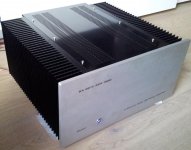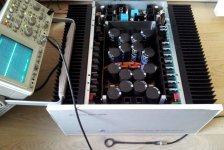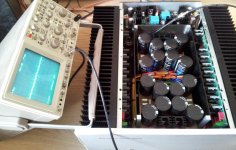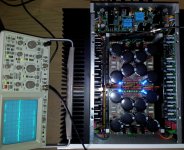[*] 111 db - Full bandwidth (~ 500kHz limit of VP-7723)
😎
My 14 years amp have 96 dB un-weighted S/N ratio 🙁
Your skill for PCB designing is awesome.
Noise of audio amplifiers is usually measured with a 10Hz to 20kHz bandwidth.
A weighting is often used.
So the two figures to use would be 121dB 10Hz to 20kHz
and 127dB A weighting.
But these are very exceptional, making me believe that the measurement bandwidths don't comply with the norm.
I understand A weighting is often presented but only because it is more favourable i.e. it presents a higher number. I am trying to compare this specs of this amplifier with two others:
1. Theta Digital's Citadel (yes, I am a Theta fan)
Unweighted signal to noise ratio >103dB
2. The NC1200 module from Hypex which underpins the Theta Prometheus
(Unweighted, add 2dB for A-weighted)
137dB Pr unbuffered
128dB Pr buffered
112dB 1W 8R unbuffered
103dB 1W 8R buffered
I do not understand the different measurements here.
PS: I'm sure this amp thrashes my nearly 20-year old Krell FPB 200
The psopho looks like what I remember what A weighting should look like.
The "audio filter" seems to have adopted a much steeper roll off than the 80kHz filter.
That would probably account for the 2dB error between these two noise figures.
The 80kHz and 20kHz noise should be 6dB different IF the noise is continuous and flat through the pass band and a bit beyond.
But even taking that 2dB into account these are still exceptional noise figures.
How do they compare to D.Self -96dBu?
-96dBu is the same as 12.7uVac at the output.
For a 200W into 8ohms amplifier with a maximum output of 40Vac, that 12.7uVac is ~ 130dB S/N
The "audio filter" seems to have adopted a much steeper roll off than the 80kHz filter.
That would probably account for the 2dB error between these two noise figures.
The 80kHz and 20kHz noise should be 6dB different IF the noise is continuous and flat through the pass band and a bit beyond.
But even taking that 2dB into account these are still exceptional noise figures.
How do they compare to D.Self -96dBu?
-96dBu is the same as 12.7uVac at the output.
For a 200W into 8ohms amplifier with a maximum output of 40Vac, that 12.7uVac is ~ 130dB S/N
Some maufacturers will misuse A weighting this way and conceal the "flat" noise figure.I understand A weighting is often presented but only because it is more favourable i.e. it presents a higher number. ..............
But that is NOT the reason that Aweighting (and all the others) exist.
A weighting gives a close approximation to how annoying we "hear" the noise.
That is why it exists.
The quote both flat and A is useful to customers.
Some maufacturers will misuse A weighting this way and conceal the "flat" noise figure.
But that is NOT the reason that Aweighting (and all the others) exist.
A weighting gives a close approximation to how annoying we "hear" the noise.
That is why it exists.
The quote both flat and A is useful to customers.
Of course. 🙄 I never argued why it existed. (I could debate your definition of A weighting but that's off-topic.) I merely stated a fact, which you repeated, that often manufacturers only disclose this more favourable headline number.
Now back to my question. As one of my comparables only publishes an unweighted statistic I'm interested in comparing it with Toni's equivalent figure. Is this 121dB or some other number to be calculated?
How do I interpret and compare the figures disclosed by the manufacturer of the NC1200?
Last edited:
I find that equivalent Ein is a useful number for comparison.
Take the flat or A weighted Noise output in µVac
convert to nVac.
Divide by the amplifier gain.
Divide by sqrt(bandwidth)
You have the Ein in nV/root Hertz.
ex.
Self's 12.7uVac *1000 =12700nVac
Gain ~30times and root bandwidth = ~141
converts the 12700 to 3nV/rtHz.
That is quiet. Quieter than a 5534.
Take the flat or A weighted Noise output in µVac
convert to nVac.
Divide by the amplifier gain.
Divide by sqrt(bandwidth)
You have the Ein in nV/root Hertz.
ex.
Self's 12.7uVac *1000 =12700nVac
Gain ~30times and root bandwidth = ~141
converts the 12700 to 3nV/rtHz.
That is quiet. Quieter than a 5534.
I understand A weighting is often presented but only because it is more favourable i.e. it presents a higher number...............
You did argue that A weighting is used "only because it is more favourable"....... I never argued why it existed. .............
That is what you typed and posted.
😎
My 14 years amp have 96 dB un-weighted S/N ratio 🙁
Referred to what voltage (1Vrms, 2.83Vrms, full output??).
The psopho looks like what I remember what A weighting should look like.
The "audio filter" seems to have adopted a much steeper roll off than the 80kHz filter.
That would probably account for the 2dB error between these two noise figures.
The 80kHz and 20kHz noise should be 6dB different IF the noise is continuous and flat through the pass band and a bit beyond.
But even taking that 2dB into account these are still exceptional noise figures.
How do they compare to D.Self -96dBu?
-96dBu is the same as 12.7uVac at the output.
For a 200W into 8ohms amplifier with a maximum output of 40Vac, that 12.7uVac is ~ 130dB S/N
Dear Andrew,
thanks for clarification. My amp has about 20uVac noise at the output A-weighted (input shorted via VP7723D / 600R).
Hope you can help finding link or details about "D.Self -96dBu?".
Unfortunately "diyaudio search" and "google" doesn't find any reference. If it is in one of his books maybe you have a page reference.
Thanks in advance! 🙂
BR, Toni
Referred to what voltage (1Vrms, 2.83Vrms, full output??).
i think it reference to 1Vrms, about 317uV...
Are the C12 and C13 part of compensation scheme or for some other reason? These
caps appeared around my VAS limiter idea and I cant find a word about them.
And to be pedantic: shouldn't be "Miller: none" at "R28 value" 😉 ?
caps appeared around my VAS limiter idea and I cant find a word about them.
And to be pedantic: shouldn't be "Miller: none" at "R28 value" 😉 ?
Are the C12 and C13 part of compensation scheme or for some other reason? These
caps appeared around my VAS limiter idea and I cant find a word about them.
And to be pedantic: shouldn't be "Miller: none" at "R28 value" 😉 ?
Thanks for bug report. You are right - R28 should be omitted if using "Miller" compensation only. I will submit a corrected version the next days if bom is ready for download.
C12/C13 are part of the compensation scheme. It betters the gain margin.
... start tuning for lowest SNR with homebrew h-field probe ... need to add some cnc machined mu-metal.
SNR from lab is as low as 125 (A-weighted)
Current SNR is about 110 db (A-weighted)
Picture 3: homebrew h-field probe
Pictures 4 and 5 are showing rectifying spikes. Using the h-field probe it is very easy to find "hum" hotspots. 😉
BR, Toni
SNR from lab is as low as 125 (A-weighted)
Current SNR is about 110 db (A-weighted)
Picture 3: homebrew h-field probe
Pictures 4 and 5 are showing rectifying spikes. Using the h-field probe it is very easy to find "hum" hotspots. 😉
BR, Toni
Attachments
Last edited:
How much of a field do the capacitors themselves emit? How large is the coil in the probe?
... just started my first h-field measurement. Have to learn, how to use it correctly.🙂
Moving around the capacitors there is much less to measure compared to the stronger fields moving around the toroids.
The coil radius of the probe is about 14mm.
Is the field probe design shown in some other Thread?
Any chance of a link?
I've built type 2(c) inspired from: Probing the Magnetic Field Probe
Used a 1.5mm diameter copper wire, two times shrink tubing around, added the wiring shield of a RG58 cable. Added a BNC socket. Final shrink tubing.
Toni,
Congratulations to this incredible amp! Very clean layout and extremely well built. Can´t wait to hear it! Best wishes, Martin
Congratulations to this incredible amp! Very clean layout and extremely well built. Can´t wait to hear it! Best wishes, Martin
... maybe worth a try with real devices ...
what do you think?
- about 4 ppm THD20K@200W@8R
- output stage with MJL3281/MJL1302 instead of TTC5200/TTA1943 (2SC5200/2SA1943)
BR, Toni
Sir, Toni can i used this circuit for HV supply, example for H classes ?
Sir, Toni can i used this circuit for HV supply, example for H classes ?
This circuit has neither been built nor tested by me. Maybe it works for a H-class output stage but needs a redimensioning of most parts if going for higher supply voltages.
- Home
- Amplifiers
- Solid State
- 2stageEF high performance class AB power amp / 200W8R / 400W4R






